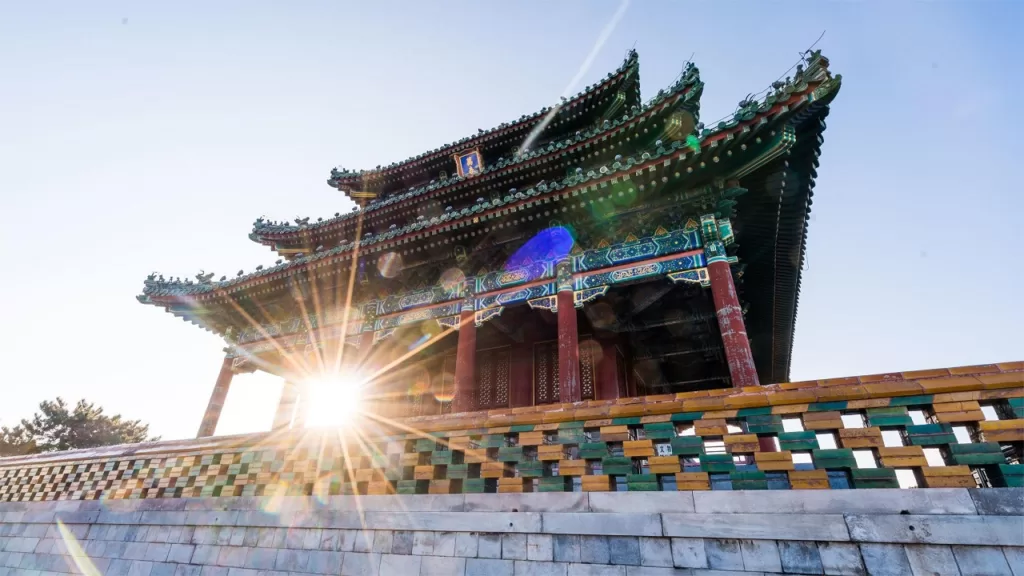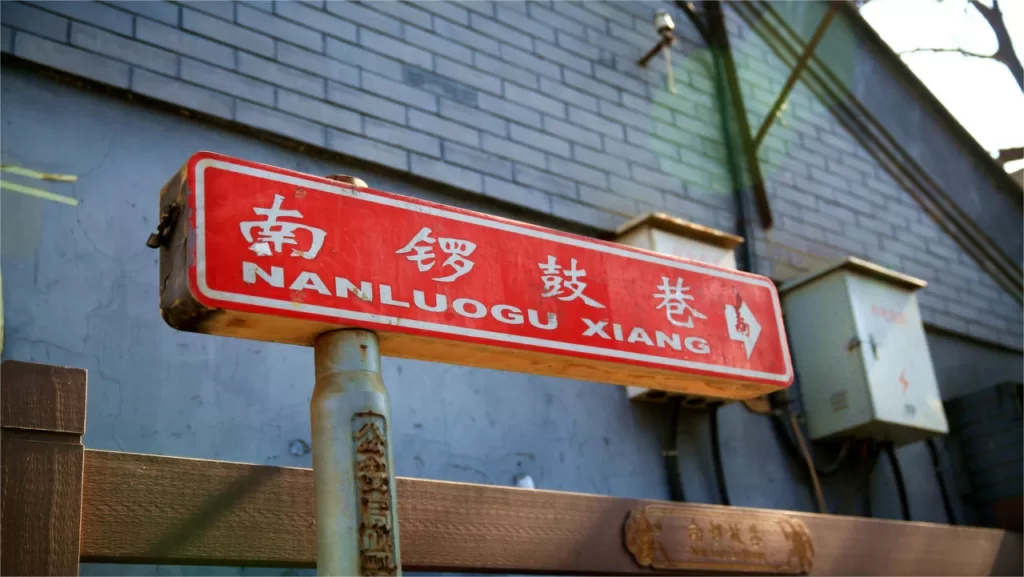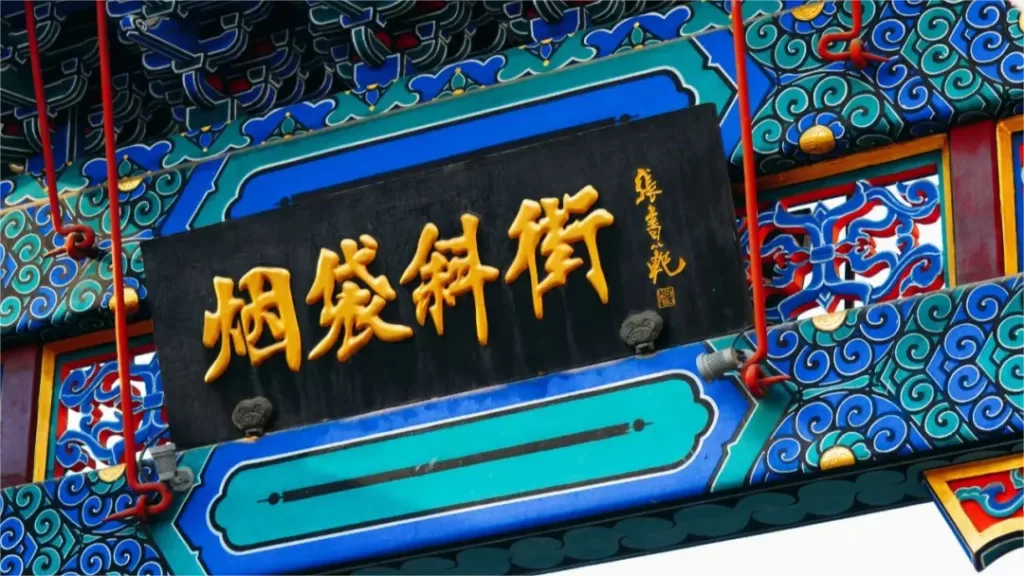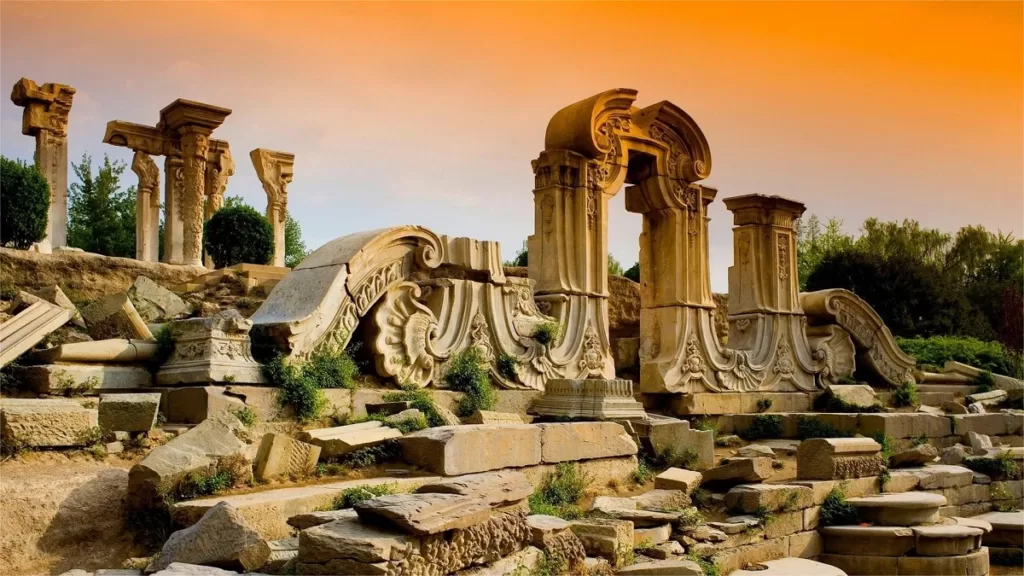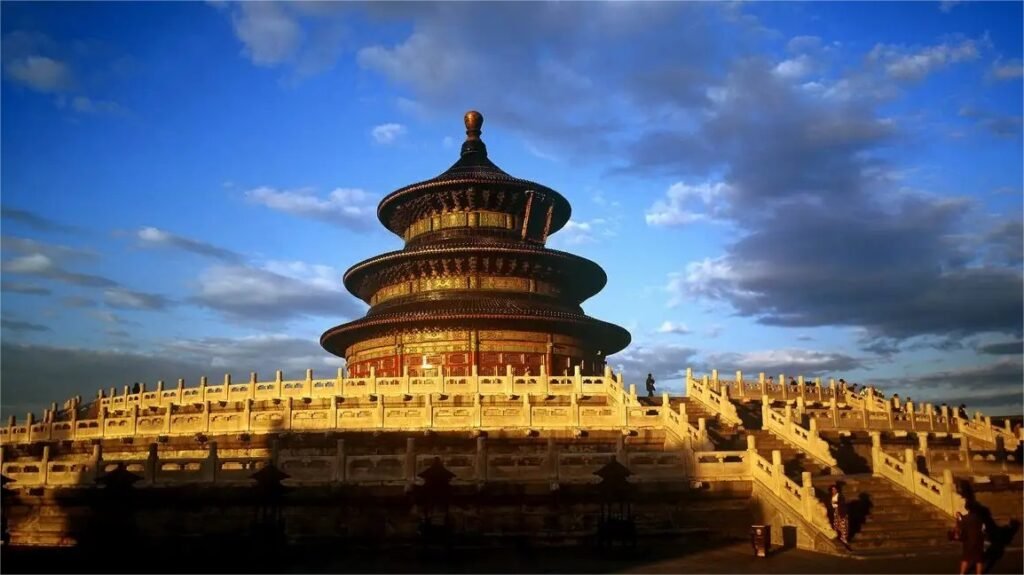Beihai Park (北海公园), covering an area of 682,000 square meters with 389,000 square meters of water and 293,000 square meters of land, is one of Beijing’s oldest and most well-preserved imperial gardens. Opened as a public park in 1925, it sits at the heart of Beijing, offering a glimpse into China’s rich imperial history.
Originally constructed during the Liao, Jin, and Yuan dynasties as a royal palace retreat, Beihai Park was transformed into an imperial garden during the Ming and Qing dynasties. Today, it stands as a classic example of a traditional Chinese royal garden with deep cultural and historical significance.
The park is centered around Beihai Lake and is divided into four main scenic areas: the North Bank Scenic Area, the East Bank Scenic Area, the Jade Island Scenic Area, and the Round City Scenic Area.
One of the park’s highlights is its expansive lake, which is rare in Beijing. The best time to enjoy the park is in the evening when visitors can take a boat ride on the lake, admiring the beautiful imperial architecture reflected in the calm waters.
Table of Contents
- Basic information
- Location and Transportation
- Highlights of Beihai Park
- Map and Recommended Routes
- Vlog about Beihai Park
- Recommended Photography Spots
- Different Boating Choices in Beihai Park
- Best Time to Visit Beihai Park
- Popular Restaurant near Beihai Park
- History of Beihai Park
- Useful Tips Summarized from Reviews
- Attractions near Beihai park
- Other Imperial Places in Beijing
Basic information
| Website | www.beihaipark.com.cn |
| Estimated length of tour | 1-3 hours |
| Ticket Price | Admission 10 RMB (from April 1st to October 31st) 5 RMB (from November 1st to March 31st) Tourist spots Jade Island: 10 RMB Round City: 1RMB Combined Ticket (including the entry to the palace and all the attractions) 20 RMB (from April 1st to October 31st) 15 RMB (from November 1st to March 31st) |
| Opening hours | The park 06.00 – 21.00 (April 1st – October 31st); Last entry: 20.30 06.30 – 20.00 (November 1st – March 31st); Last entry: 19.30 Tourist spots 08.00 – 18.00 (April 1st – October 31st); Last entry: 17.30 08.30 – 17.00 (November 1st – March 31st); Last entry: 16.30 Closed on Monday |
Location and Transportation
Beihai Park is right next to the Forbidden City, to its northwest corner. If you leave the city from the north gate and turn west, you will reach the park’s south gate within 10-minute walk.
To the north gate:
- Bus: take No. 13, 42, 107, 111, 118, 612, or 701 and get off at the North Gate of Beihai Park Stop (Beihai Gongyuan Beimen).
- Subway: take subway line 6 and get off at the North Gate of Beihai Station (Beihai Bei)
To the east gate:
- Bus: take No. 5 and get off at West Banqiao Stop (Xibanqiao)
To the south gate:
- Bus: take No. 5, 101, 103, 109, 124, or 128 and get off at Beihai Stop.
Highlights of Beihai Park
North Bank Scenic Area
Xiao Xi Tian (小西天)
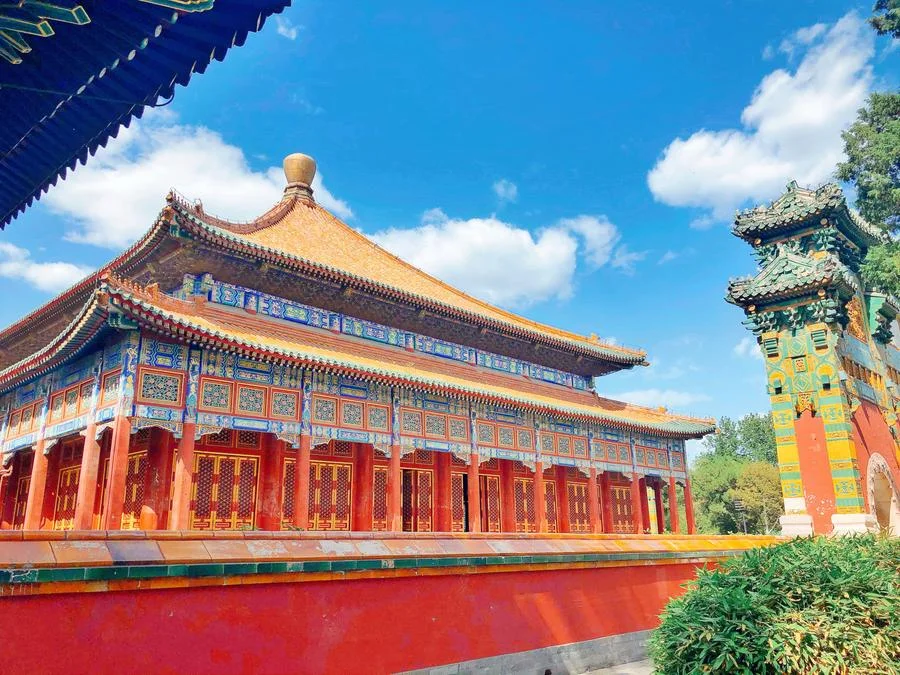
Xiao Xi Tian, or Little Western Heaven, is a magnificent structure located on the North Bank of Beihai Park. It was originally constructed during the 33rd year of the Qianlong Emperor’s reign in the Qing Dynasty (1768 AD) and completed two years later in 1770 AD. This impressive edifice was built by Emperor Qianlong to celebrate the birthday of his mother, Empress Dowager Chongqing, and to pray for her health and happiness.
The central feature of Xiao Xi Tian is the Jile Shijie (Extreme Joy World), which covers a vast area of 1,200 square meters, making it the largest square pavilion-style palace structure in China. The pavilion’s architectural design is notable for its grand scale and intricate craftsmanship. Its main hall boasts a beam span of 13.5 meters and is adorned with exquisite Nanmu wood screens that are finely carved with floral patterns. High above the entrance hangs a golden plaque bearing the inscription “极乐世界” (Extreme Joy World) in the calligraphy of Emperor Qianlong himself. The ceiling features a dazzling octagonal dome adorned with a dragon motif, adding to the hall’s opulent ambiance.
Surrounding the pavilion is a serene expanse of water, connected by elegant bridges that allow visitors to circumnavigate the structure. At each of the four cardinal directions—east, west, south, and north—there are intricately designed glazed archways, with small square pavilions situated at each corner. To the south, a crescent-shaped river flows gently beneath a beautifully sculpted stone bridge with intricate railings. Inside the pavilion, there was originally a clay sculpture of the South Sea’s Putuo Mountain, featuring 226 statues of Arhats on the mountain and a painted sea below, symbolizing the Buddhist paradise of Putuo. This area is thus also known as “Luohan Mountain” and “Sea Island.”
Iron Shadow Wall (铁影壁)
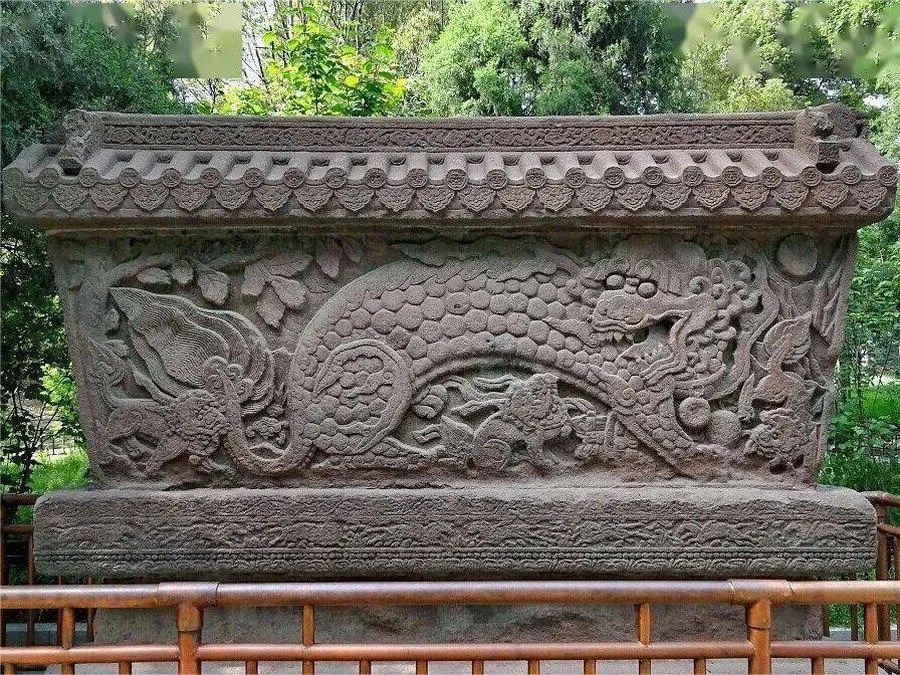
The Iron Shadow Wall is a historical relic from the Yuan Dynasty, characterized by its unique brownish color and iron-like texture. It is crafted from neutral volcanic rocks and stands 1.89 meters high and 3.56 meters long. The wall’s surface is adorned with shallow carvings of cloud patterns and mythical beasts, reflecting the ancient artistry of the period.
Originally, the Iron Shadow Wall was placed in front of an ancient temple outside Jian De Men (now De Sheng Men). During the early Ming Dynasty, it was relocated to the front of the Guo Shou Temple at De Sheng Men (now Iron Shadow Wall Alley). In 1947, it was moved to Beihai Park, and in 1986, the base of the wall was recovered from Iron Shadow Wall Alley, allowing for the restoration of this important cultural artifact to its current location.
Nine-Dragon Wall (九龙壁)
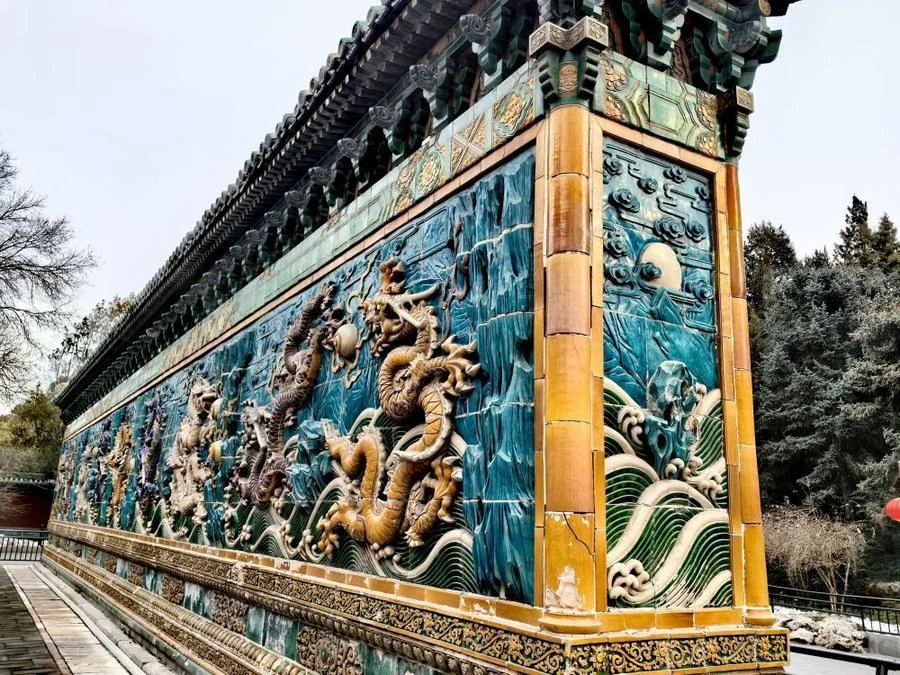
The Nine-Dragon Wall is one of Beihai Park’s most renowned features, originally situated in front of the Dazheng Mirror Wisdom Palace. Constructed in the 21st year of Emperor Qianlong’s reign during the Qing Dynasty (1756 AD), this wall is a remarkable example of traditional Chinese architectural art. Standing 5.96 meters high, 1.60 meters thick, and 25.52 meters long, the Nine-Dragon Wall is adorned with vibrant, multi-colored glazed bricks. The wall’s two sides each feature nine magnificent dragons soaring amidst clouds and waves. A total of 635 dragons—both large and small—are intricately carved into the wall’s surface. This wall is one of only three ancient Nine-Dragon Walls in China, the others being located in the Forbidden City and Datong. Unique among these, the Beihai Nine-Dragon Wall is distinguished by its double-sided design, making it a rare and valuable example of ancient Chinese decorative arts.
Kuai Xue Tang (快雪堂)
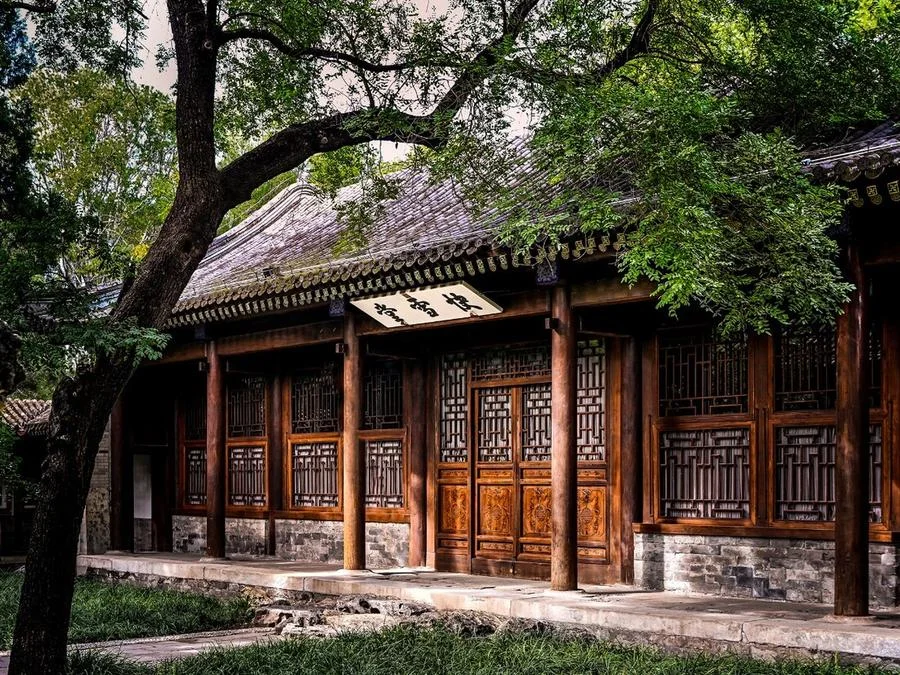
Kuai Xue Tang, or Fast Snow Hall, was established in the 44th year of Emperor Qianlong’s reign (1775 AD). This elegant hall complex includes the Chengguang Hall and the Yulan Pavilion, all connected by intricately painted walkways. The hall is famous for its rich collection of calligraphy, featuring 48 stone slabs inscribed with works from 20 famous calligraphers spanning the Jin to Yuan dynasties. Among these, Wang Xizhi’s “Kuaixue Shiqing Tie” (Letter of Snow in Spring) and Emperor Qianlong’s own “Kuaixue Tang Ji” (Fast Snow Hall Inscription) are particularly renowned.
Western Heaven Realm (西天梵境)

The Western Heaven Realm, also known as Da Xi Tian, is one of the most celebrated attractions in Beihai Park. This scenic area is located to the east of Jingxin Studio and to the west of the Dazheng Mirror Wisdom Palace, forming a harmonious line with the Jade Island to the south. Originally established during the Ming Dynasty as a Tibetan Buddhist temple, it was extensively renovated and expanded in the 24th year of Emperor Qianlong’s reign (1759 AD) during the Qing Dynasty. After a significant restoration in 1980, the Western Heaven Realm was reopened to the public.
The Western Heaven Realm is known for its exquisite architectural design and serene atmosphere. The central feature of this area is the Xitian Fan Jing, or Western Heaven Realm Pavilion, which serves as the heart of the complex. This grand pavilion is surrounded by tranquil gardens and reflects the classic elements of Chinese imperial architecture. Visitors to the Western Heaven Realm can explore a range of structures and features, including majestic pavilions, peaceful courtyards, and intricate stone carvings.
Jingxin Studio (静心斋)
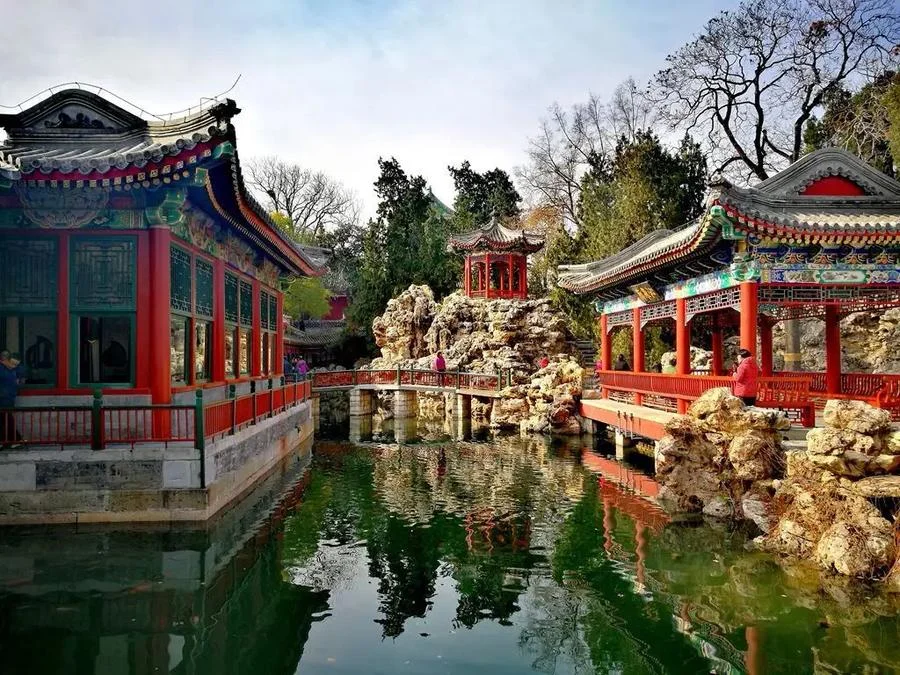
Jingxin Studio, covering an area of approximately 8,700 square meters, is one of the most refined and elegant sections of Beihai Park. Originally a simple residence from the Ming Dynasty, it was transformed into a beautiful garden by Emperor Qianlong in the 22nd year of his reign (1757 AD) during the expansion of the Western Heaven Realm. Known also as the “Qianlong’s Little Garden,” this area features a range of charming structures and landscapes.
Notable buildings in Jingxin Studio include the Jingxin Studio itself, Book House,Melodious Qin Studio, Emerald Pavilion, Tea-Roasting Workshop, Painted Garden, Spring Water Gallery, Mountain View Pavilion, and Stone Bridge. The design of Jingxin Studio is a blend of Northern and Southern garden styles, combining the grandeur of northern gardens with the delicate and refined charm of Jiangnan private gardens.
Five-Dragon Pavilion (五龙亭)
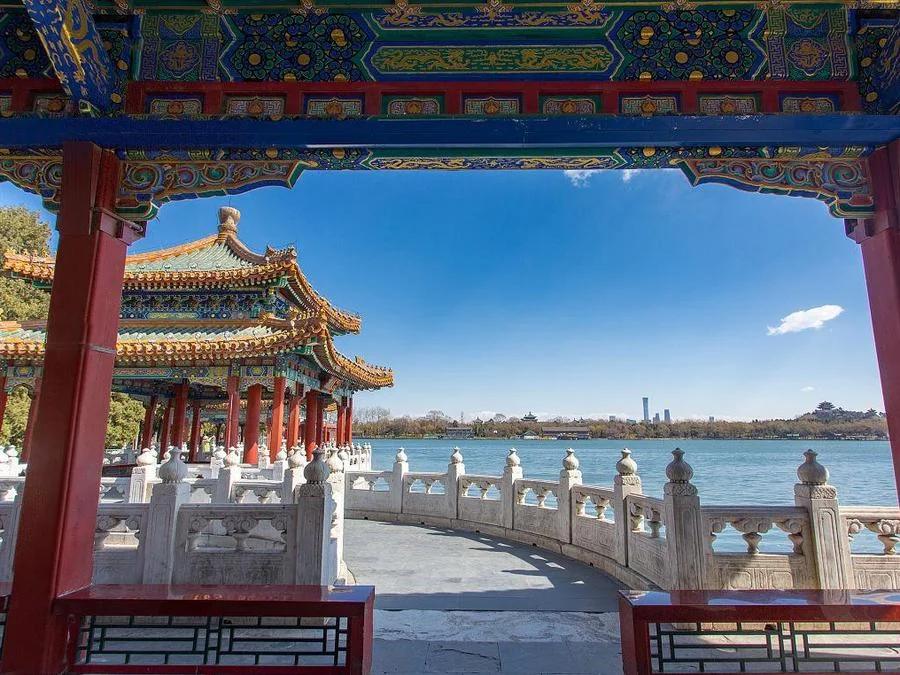
The Five-Dragon Pavilion was originally built in the 30th year of the Wanli Emperor’s reign during the Ming Dynasty (1602 AD). This historic structure was a favored spot for the emperor and his close attendants to enjoy fishing and moon-gazing. The pavilion complex consists of the central Longze Pavilion, with the surrounding pavilions including Yong Rui Pavilion (Fortune Pavilion), Fu Cui Pavilion (Jade Pavilion), Cheng Xiang Pavilion (Auspicious Pavilion), and Zi Xiang Pavilion (Fragrant Pavilion).
In the 28th year of Emperor Qianlong’s reign (1763 AD), the wooden arch bridge was replaced with a stone bridge, featuring elegant bluestone railings and columns. However, during the Boxer Rebellion in 1900, the railings and columns were damaged by the Eight-Nation Alliance. A meticulous restoration in 1974 restored the pavilion to its former glory. Today, the Five-Dragon Pavilion is a popular spot for visitors to relax and enjoy panoramic views of the White Pagoda and the scenic beauty of Beihai Lake.
East Bank Scenic Area
Haopu Garden (濠濮间)
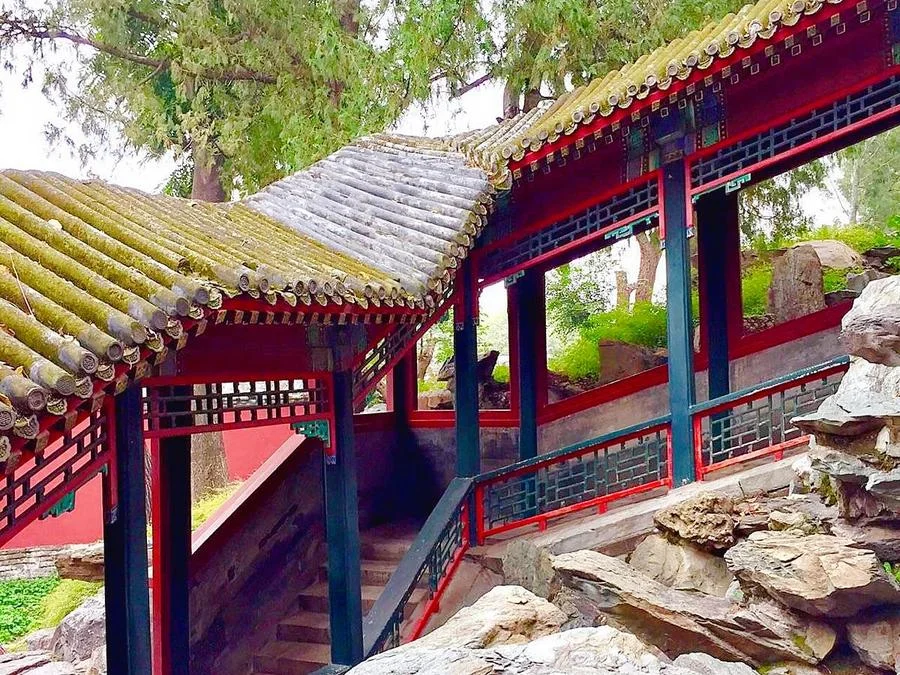
Haopu Garden is a charming and contemplative garden located at the northern end of the small hill on the eastern shore of Beihai Park. It is an exquisite example of a “garden within a garden,” designed to evoke the classical beauty of ancient Chinese water gardens. The name “Haopu” references two ancient Chinese water names. According to Zhuangzi’s “Autumn Water” chapter, Zhuangzi and Hui Shi were walking on the Hao Bridge, where Zhuangzi remarked on the happiness of the fish swimming below. Hui Shi questioned how Zhuangzi could know the fish’s joy since he was not a fish himself, to which Zhuangzi responded that Hui Shi could not understand his knowledge of the fish’s joy as he was not Zhuangzi. Inspired by this philosophical exchange, the garden was created to offer a serene environment where the emperor and empress could enjoy observing fish and fishing.
The garden features a series of small bridges that arch gracefully over the water, offering visitors beautiful views and a peaceful setting for reflection. Historically, Emperor Qianlong used to host banquets for his ministers here, adding a layer of historical significance to the serene landscape.
Huafang Studio (画舫斋)
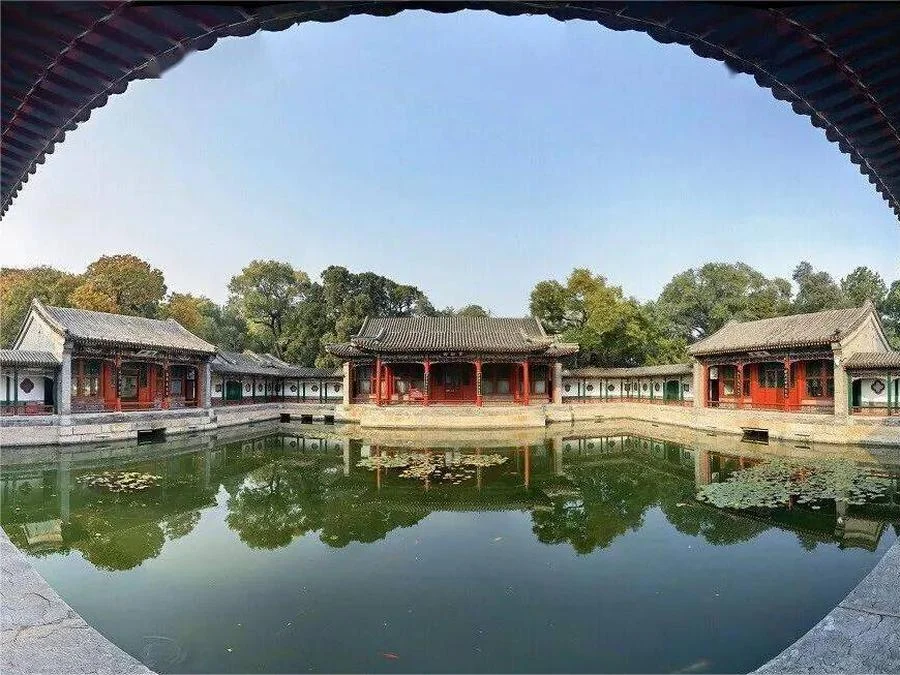
Huafang Studio is a notable structure situated on the eastern shore of Beihai Park, built during the 22nd year of Emperor Qianlong’s reign in the Qing Dynasty (1757 AD). The central building of Huafang Studio is the Chun Yu Lin Tang (Spring Rain on the Pond), which features a small pond and serves as the front hall of the studio. The main hall, Huafang Zhai, is located to the north and is surrounded by two courtyards: Gu Ke Ting (Ancient Tea Garden) to the east and Xiao Ling Long (Small Delicate Courtyard) to the west. The entire studio is encircled by red-painted colonnades and is designed to resemble a large boat docked at the edge of Beihai Lake. The design was inspired by the Huafang Zhai Ji (Record of Huafang Studio) written by the scholar Ouyang Xiu, which describes a similar scenic and intellectual retreat. Emperor Qianlong frequently visited Huafang Studio for leisure, and it was also a residence for Emperor Guangxu and a popular venue for Empress Dowager Cixi’s banquets and storytelling sessions.
Xian Can Altar (先蚕坛)
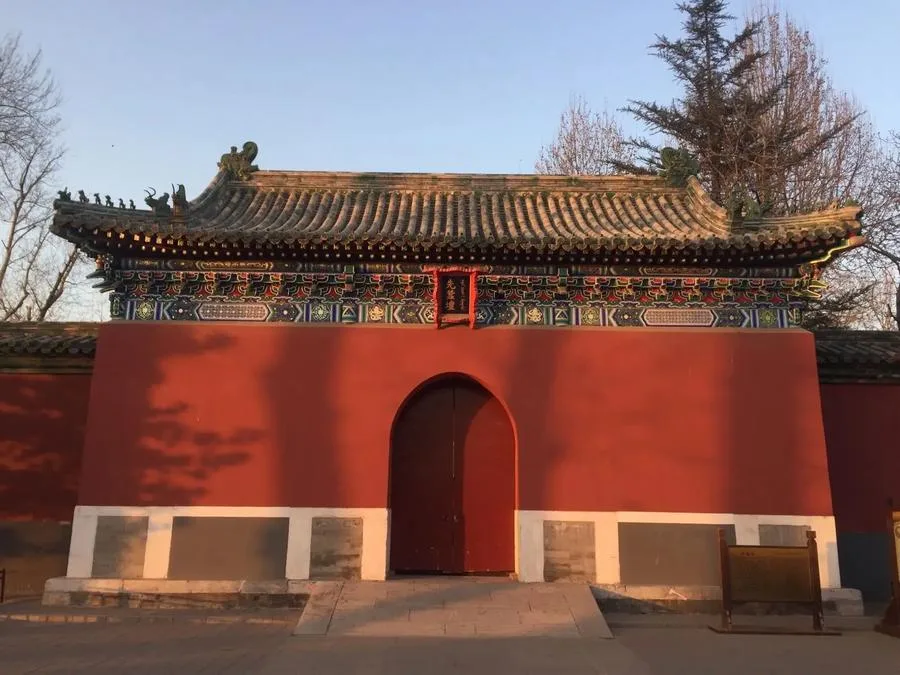
Xian Can Altar is located at the northeastern corner of Beihai Park, covering an area of 17,000 square meters. Originally the site of the Ming Dynasty’s Leiting Hongying Hall, it was transformed into Xian Can Altar in the 7th year of Emperor Qianlong’s reign (1742 AD) as a place for the imperial consorts to worship the “Silkworm Deity.”
The altar’s layout includes several notable structures: Guan Sang Tai (Mulberry Viewing Platform), Qin Can Dian (Silkworm Shrine), Hou Dian (Rear Shrine), Xian Can Shen Dian (Deity Altar for Silkworms), Shen Chu (Sacred Altar), Can Shu (Silkworm Pavilion), Jing Ting (Well Pavilion), Sheng Ting (Sacrifice Pavilion), Can Suo (Silkworm House), You Lang (Leisure Corridor), Sang Yuan (Mulberry Garden), Yu Can Chi (Bathing Silkworm Pond).
The eastern side of Xian Can Altar features a small river called Yu Can He (Bathing Silkworm River), which was originally a tributary of the Jinshui River introduced to the eastern side of Beihai Park during the Yuan Dynasty. Xian Can Altar is one of the nine royal altars in Beijing and is a well-preserved example of a royal site dedicated to the worship of the silkworm deity.
Jade Island Scenic Area
Qionghua Island (琼华岛)

Qionghua Island, often simply known as Qiong Island or Jade Island, is a stunning feature of Beihai Park, characterized by the iconic White Pagoda that stands proudly atop it. The island rises 32 meters above the lake and measures 913 meters in circumference, offering a picturesque escape in the heart of Beijing. The name “Qionghua” translates to “beautiful jade,” reflecting the island’s design as a jewel-like paradise. According to Chinese mythology, Qionghua refers to a legendary flower from a magical tree on Penglai Island, believed to grant immortality to those who consume it. This mythical reference underscores the island’s role as a place of extraordinary beauty and tranquility.
In the early Qing Dynasty, the island served a strategic purpose; a signal cannon was installed at its summit to provide early warnings of any potential threats. Today, this historical feature adds an element of intrigue to the island’s serene environment.
The western side of Qionghua Island was originally designed for imperial leisure and gatherings. Here, the Yuexin Hall served as a retreat where the emperor could relax, hold discussions, or host banquets. Adjacent to the hall is the Qingxiao Tower, where Emperor Qianlong enjoyed wintertime iceball games with his mother.
Yong’an Bridge (永安桥)
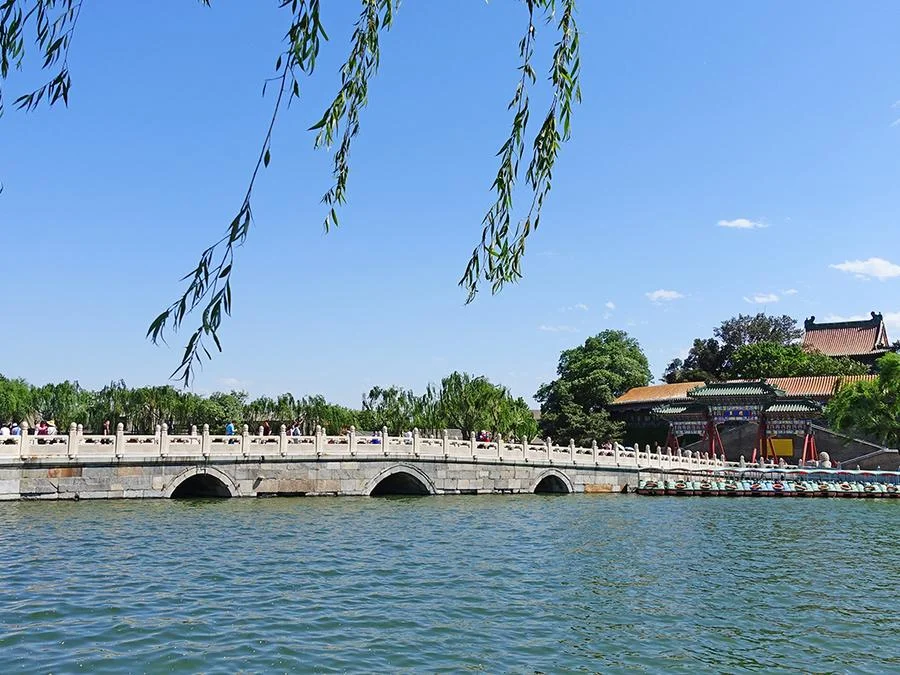
Yong’an Bridge is one of the most significant structures in Beihai Park, with a rich history and distinctive design. Originally a wooden bridge during the Yuan Dynasty, it was later known as Taiye Bridge during the Ming Dynasty. In the eighth year of Emperor Qianlong’s reign (1743 AD), the bridge was rebuilt as a striking three-arched stone structure featuring a unique zigzag design.
This bridge connects Qionghua Island to the southern shore of Beihai Park and serves as both a practical crossing and a historical monument. The bridge is adorned with 48 lotus-shaped columns and lotus leaf-patterned railings, which were added during a comprehensive restoration in 1979. Yong’an Bridge masterfully links the Round City Gate on the southern shore with the Yong’an Temple on the island, creating a harmonious connection between the two locations. At each end of the bridge, visitors encounter ancient stone lions and a historical archway, which enhance the bridge’s majestic appearance and historical significance.
Yong’an Temple (永安寺)

Yong’an Temple is a historic site located at the southern foot of White Pagoda Mountain in Beihai Park. Originally established in the eighth year of the Shunzhi reign of the Qing Dynasty (1651 AD), it was initially named Baita Temple. The temple was built at the request of the Tibetan Lama Naomu Khan by the Qing Emperor Shunzhi, reflecting a significant moment of religious and cultural exchange.
At its inception, Yong’an Temple featured several key buildings including the Zhengjue Hall, Pu’an Hall, Shengguo Hall, Zongjing Hall, Zhuanjiaofang (Corner Room), Shunshan Room, and the White Pagoda itself. The Zhengjue Hall served as the main gate of the temple complex. Over time, many of the original structures and statues in Yong’an Temple were lost or damaged due to historical events. However, in 1993, the park’s management undertook a comprehensive restoration project to preserve and rebuild the temple’s historical buildings and statues, faithfully restoring the temple’s former glory and cultural significance.
Reading Ancient Books Tower (阅古楼)
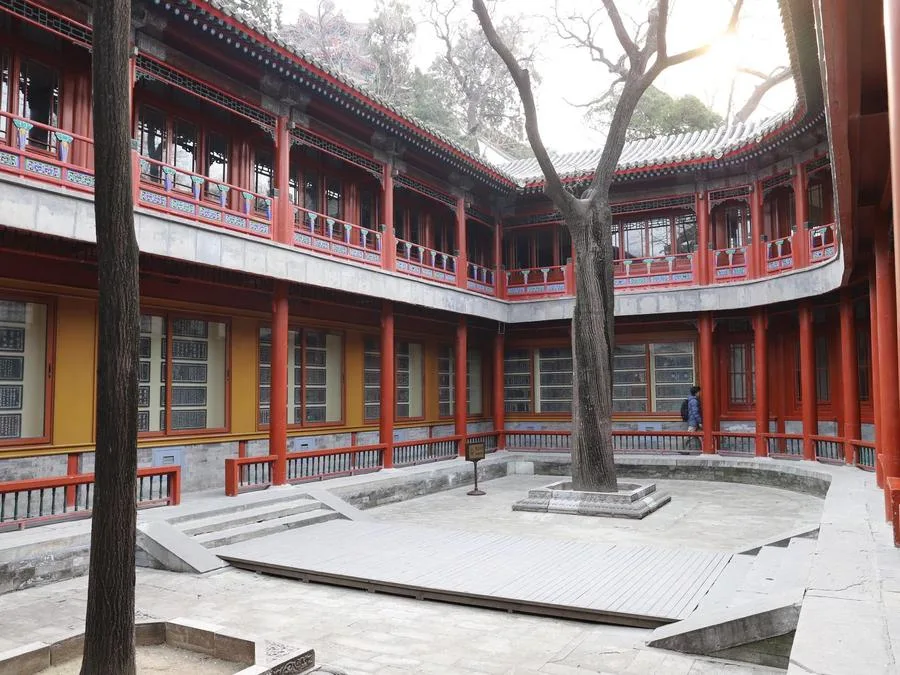
Yuegu Tower, also known as the Reading Ancient Books Tower, is situated on the western slope of White Pagoda Mountain in Beihai Park. Constructed in the twelfth year of Emperor Qianlong’s reign (1747 AD), the tower features a distinctive elliptical layout, comprising two concentric semicircles that create a unique two-story structure.
The tower is renowned for its collection of ancient calligraphy and inscriptions. Its walls are adorned with 495 stone carvings of famous calligraphic works from the Wei and Jin Dynasties to the Ming Dynasty, compiled under the direction of the scholar Liang Shizheng and others. This collection, known as the “Three Rarities Hall Calligraphy”, features approximately 100,000 characters from the works of 135 renowned calligraphers, spanning various styles including regular script, cursive script, and running script.
Bronze Immortal Holding Dew Basin (铜仙承露盘)
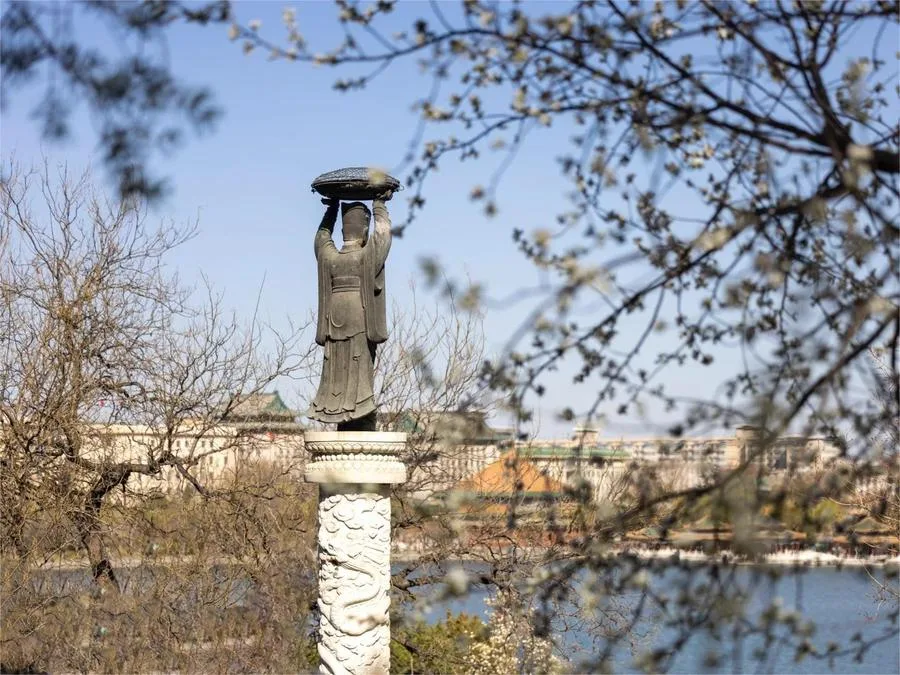
The Bronze Immortal Holding Dew Basin was constructed during the Qianlong reign of the Qing Dynasty, inspired by a story from the Han Dynasty. Standing 6.6 meters tall, this elegant structure features a white marble dragon column supporting a bronze figure holding a basin with both hands.
The concept for this basin is derived from the tale of Emperor Wu of the Han Dynasty, who placed a similar basin at the Shenming Terrace in the Jianzhang Palace. This basin was believed to capture dew, which, according to legend, could be used for elixirs of immortality. However, Emperor Qianlong’s creation of the Bronze Immortal Holding Dew Basin was not intended for capturing dew but rather served as a decorative and symbolic element within the landscape design of Beihai Park.
Yilan Hall (漪澜堂)

Yilan Hall is a distinctive historical architectural ensemble located on the northern side of Qiong Hua Island in Beihai Park. Built in the sixteenth year of Emperor Qianlong’s reign (1751 AD), this elegant complex was inspired by the architectural style of the Jinshan Temple in Zhenjiang, Jiangsu Province, which Emperor Qianlong had admired during his southern tours.
Yilan Hall, which means “Rippling Waves Hall,” is designed to evoke a sense of scholarly elegance rather than religious grandeur. The entire area is surrounded by a long corridor along the water, creating a tranquil and reflective atmosphere for visitors. The complex covers an area of 6,783 square meters, with the main building area being 563 square meters. It includes several significant structures: Yilan Hall itself, Bizhao Tower, Daoning Studio, Yuan Fan Pavilion, Qinglan Huayun (Sunny Veranda), and a traditional Opera Stage.
Yilan Hall was originally a place where Emperor Qianlong enjoyed reading and composing poetry. The Daoning Studio served as a venue for the emperor and his scholars to engage in literary pursuits. Bizhao Tower, located on the eastern side of the central corridor, and Yuan Fan Pavilion, on the western side, are two-story towers providing elevated views of the park. The Sunny Veranda was used for watching performances on the traditional stage.
Round City Scenic Area
Round City (团城)

Round City, originally a small island in the Taiye Pool, was a part of the Daming Palace during the Jin Dynasty. In the Yuan Dynasty, it was known as “Yuandhi” or “Yingzhou,” referring to a mythical island paradise. During the Qianlong period of the Qing Dynasty, Round City underwent significant renovations and the construction of the Yuweng Pavilion.
Round City features a distinctive circular layout, surrounded by high city walls built from tightly fitted bricks. The base of the city walls rises 4.6 meters above the water level, with a circumference of 276 meters and an area of 4,553 square meters. On the east and west sides of the city walls, there are gate towers known as Zhaojing on the east and Yanxiang on the west. Visitors can ascend the city walls via a series of stone steps, which are adorned with cover doors at various points. The layout of the buildings on top of the city walls follows a symmetrical, garden-inspired arrangement.
Chengguang Hall (承光殿)
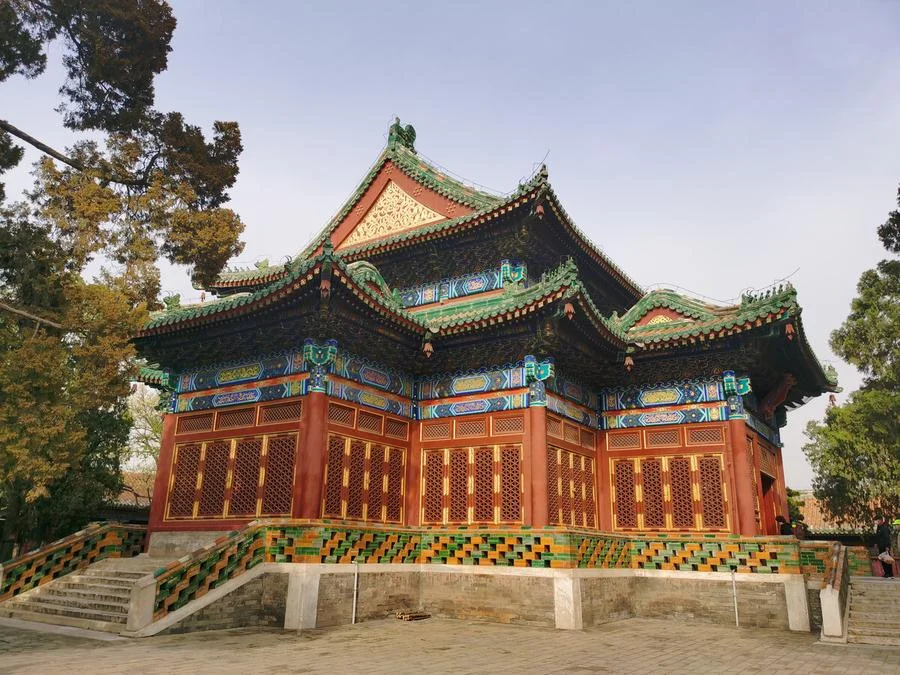
Chengguang Hall is the primary structure on Round City and was originally known as the Yitian Hall during the Yuan Dynasty. Rebuilt during the 29th year of Emperor Kangxi’s reign (1690), it was renamed Chengguang Hall. The hall features a distinctive square layout with a double-eaved hip roof.
The hall’s architecture is notable for its unique design, which is rare among Beijing’s palace buildings. It is a square structure with a cross-shaped floor plan, where the central hall is surrounded on four sides by smaller auxiliary halls, each with a single eaved roof and covered with yellow glazed tiles with green trim. The roof edges are adorned with decorative eaves, and the hall’s interior is embellished with intricate gilded paintings.
Jade Urn (玉瓮)
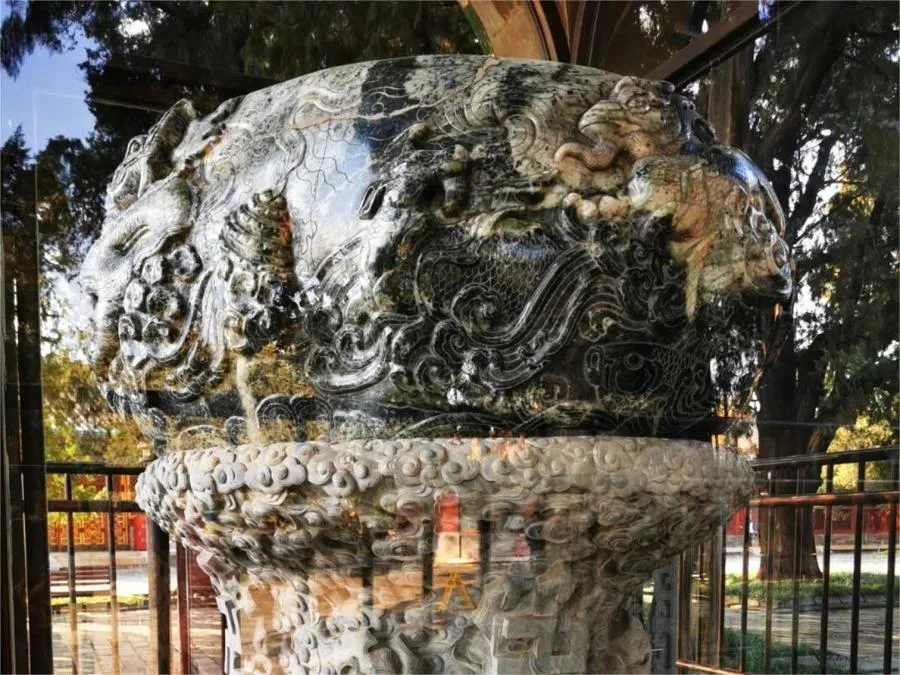
The Yuweng (Jade Urn), also known as the “Dushan Great Jade Sea,” was crafted in the second year of the Yuan Dynasty’s Zhiyuan period (1265). This magnificent jade urn stands 70 cm tall with an elliptical opening, a circumference of 493 cm, and weighs approximately 3,500 kilograms. Its surface features intricate reliefs of sea dragons, seahorses, sea pigs, and sea rhinos amidst swirling waves, rendered with vivid detail.
Originally, the Yuan Emperor Kublai Khan placed the Yuweng in the Guanghan Palace on Qionghua Island, where it was used for grand feasts. After the palace’s collapse during the Ming Dynasty, the urn was lost to the public. In the tenth year of the Qing Emperor Qianlong’s reign (1745), the Yuweng was rediscovered, and Emperor Qianlong valued it highly, moving it to the Chengguang Hall in 1749. He commissioned forty scholars to inscribe poems on the pavilion’s pillars, commemorating the urn.
Map and Recommended Routes

1. South Gate Entrance – 2-Hour Easy Version
Route: South Gate → Tuan Cheng (Round City) → Beihai South Gate → Yong’an Bridge → Yong’an Temple → White Pagoda → Descend Eastward → Qiongdao Chun Yin Stele → Long Corridor → Yilan Hall, Daoning Study → Yuegu Lou → Return to Yong’an Bridge → Exit at South Gate
2. South Gate Entrance – 4-Hour Detailed Version
Route: South Gate → Tuan Cheng (Round City) → Qionghua Island → Yilan Hall → Zhi Shan Bridge → Hao Pu Stream → Jingxin Studio → Western Heavenly Realm → Nine-Dragon Screen → Kuai Xue Studio → Chan Fu Temple → Five-Dragon Pavilion → Exit at West Gate
3. North Gate Entrance – 2-Hour Easy Version
Route: North Gate → Western Heavenly Realm → Nine-Dragon Screen → Five-Dragon Pavilion → Five-Dragon Pavilion Pier (Take Boat to Qionghua Island) → White Pagoda → Yong’an Bridge → Qionghua Island Pier (Return to Five-Dragon Pavilion Pier) → Exit at North Gate
4. North Gate Entrance – 4-Hour Detailed Version
Route: North Gate → Western Heavenly Realm → Nine-Dragon Screen → Chan Fu Temple → Wan Fo Lou Ruins & Stele → Pure Land World Hall → Five-Dragon Pavilion → Five-Dragon Pavilion Pier (Take Boat to Qionghua Island) → White Pagoda → Yong’an Bridge → Lotus Flower Viewing → Hao Pu Stream → Hua Fang Studio → Exit at North Gate
Vlog about Beihai Park
Recommended Photography Spots
1. West Shore of Beihai Park
From the west shore of Beihai Park, you can capture the picturesque scene of Wanchun Pavilion at Jingshan Park with the towering China Zun skyscraper in the distance. This view is particularly enchanting when the full moon rises, creating a beautiful contrast against the historical architecture and modern skyline.
2. North Shore of Beihai Park at Dusk
The White Pagoda and Wanchun Pavilion are illuminated as the sun sets, creating a beautiful night scene that is often more striking than during the day.
3. East Shore of Beihai Park at Sunset
At sunset, the White Pagoda becomes especially majestic, and the sunset glow reflects on the lake’s surface. This is a great opportunity to capture the beauty of the evening sky and the peaceful scene of wild ducks on the water.
4. White Pagoda’s Observation Deck
The observation deck at the top of the White Pagoda offers a sweeping view of the lake and the East Shore’s Boat Dock.
5. Yong’an Bridge South Side
From the south side of Yong’an Bridge, you can photograph the White Pagoda from a frontal view.
Different Boating Choices in Beihai Park
Beihai Park offers a variety of boating options for visitors to enjoy its scenic beauty from the water. Here’s a detailed introduction to the different boating choices available in the park:
1. Small Ferry Boat
- Description: A small ferry boat that can accommodate around 20 people for short trips between different docks.
- Route: Operates between various docks for brief, 1-2 minute trips.
- Price: 5 RMB per person.
- Ideal For: Quick and inexpensive transportation between docks.
2. Large Ferry Boat
- Description: A larger ferry offering a single-route journey across the lake.
- Route: From Yilan Hall Dock to the Five-Dragon Pavilion Dock.
- Price: 20 RMB per person for a one-way trip.
- Ideal For: A more leisurely and scenic boat ride across the lake.
3. Dragon Boat Tour
- Description: A traditional dragon boat offering a fun and immersive lake experience.
- Price: 50 RMB per person, no deposit required.
- Ideal For: Those looking for a unique, traditional boating experience.
4. Duck-Shaped Electric Boat
- Description: A popular duck-shaped electric boat, especially loved by children.
- Dock: Lin Guang Dian Dock.
- Price: 200 RMB per hour, deposit 400 RMB.
- Capacity: 4 people (including infants).
- Features: Equipped with a canopy, but remember to apply sunscreen as it does not completely shield you from the sun.
5. Lotus-Shaped Electric Boat
- Description: A lotus-shaped electric boat that’s also a favorite among kids.
- Price: 320 RMB per hour, deposit 800 RMB.
- Capacity: 8 people (including infants).
6. Lotus Viewing Rowboat
- Description: A traditional rowboat for a serene lotus viewing experience.
- Price: 40 RMB per person for 30 minutes, 60 RMB per hour.
- Group Option: For groups, it’s better to book the whole boat:
- 380 RMB for half an hour
- 580 RMB for one hour
Best Time to Visit Beihai Park
Beihai Park is a beautiful destination year-round, but the best times to visit are in spring and autumn. These seasons offer the most pleasant weather and stunning natural beauty, making them ideal for exploring the park’s scenic landscapes.
Spring (April to May): Spring is one of the most enchanting times to visit Beihai Park. During this period, the park comes alive with blooming flowers and lush greenery. The air is filled with the gentle fragrance of blossoms, creating a picturesque setting for leisurely strolls and photography.
Autumn (September to October): Autumn transforms Beihai Park into a colorful canvas of red, orange, and gold. This is a fantastic time for photographers and nature lovers to experience the park’s fall foliage and enjoy the crisp, cool air.
Summer (June to August): Although the park’s lush greenery provides shade, the hot weather and large crowds might affect your experience. Additionally, summer is the peak season for mosquitoes, so be prepared with insect repellent.
Winter (November to February): Winter offers a quieter, more tranquil experience. While the scenery may appear more subdued, the frozen lake creates a unique winter landscape. Be aware that it can be quite cold, and some attractions might be closed or have restricted access.
Popular Restaurant near Beihai Park
1. Fangshan Restaurant – 仿膳饭庄
- Address: Near Kuaixuetang, Di’anmen West Street, Beihai Park
- Phone: 010-64041184
- Hours: 11:00-14:00, 17:00-20:00
- Features: Fangshan Restaurant is renowned for its imperial cuisine and palace-style decor. The restaurant features dragon and phoenix-themed decorations and uses Qing dynasty-style porcelain or silverware. Popular dishes include walnut crisps, peanut crisps, General Tso’s chicken, and imperial roast duck. The service is also highly praised.
2. Ri Chang Restaurant (Di’anmen Branch) – 日昌餐馆(地安门店)
- Address: No. 14 Di’anmen West Street
- Phone: 17310331910
- Hours: 10:00-21:30
- Features: Ri Chang Restaurant offers authentic Cantonese cuisine at affordable prices. The menu is diverse, featuring both classic and innovative dishes. The restaurant is well-regarded for its environment and service.
3. Courtyard New Beijing Cuisine · Roast Duck (Di’anmen Branch) – 院落新京菜·烤鸭(地安门店)
- Address: No. 119 Di’anmen West Street
- Phone: 010-66570747
- Hours: 11:00-14:00, 16:30-21:00
- Features: This restaurant specializes in new Beijing cuisine and roast duck, known for its crispy skin and tender meat. It also offers a variety of other Beijing dishes. The courtyard-style decor provides a comfortable dining atmosphere.
4. Imperial Icehouse Courtyard (Di’anmen Branch) – 皇家冰窖小院(地安门店)
- Address: No. 5 Alley 5, Gongjian Hutong, Xicheng District, Beijing
- Features: Imperial Icehouse Courtyard is a creative cuisine restaurant with a unique historical background and location. The menu blends traditional Chinese dishes with innovative Western elements. The distinctive environment offers a special dining experience.
5. Other Recommendations
- Nanmen Shuanrou – 南门涮肉: A hotpot restaurant specializing in authentic Beijing lamb hotpot.
- Emei Restaurant (Di’anmen Branch) – 峨嵋酒家: Known for its authentic Sichuan cuisine at reasonable prices.
- TRB Hutong: A Western restaurant located on Shatan North Street in Dongcheng District. Though a bit farther from Beihai Park, it’s worth a visit.
History of Beihai Park
Beihai Park, originally a lake called Jin Hai in the northeast of Yanjing City during the Liao Dynasty, was centered around a small island named Yao Yu. The Liao Dynasty constructed the “Yao Yu Palace” here. During the Jin Dynasty, from 1163 to 1179, Emperor Shizong modeled Qionghua Island after the Genyue Garden in Bianliang (now Kaifeng, Henan). They brought a large number of Taihu stones from the Genyue imperial garden to build rockeries and grottoes, establishing the Da Ning Palace (also known as the Tai Ning Palace) centered around Yao Yu (now Beihai). This marked the initial formation of the imperial garden layout seen today. The soil excavated to create “Jin Hai” was used to expand the island, known as Qionghua Island, and the water was named Xihua Pond. The Guanghan Palace and other buildings were also renovated at that time.
From 1264 to 1271, during the Yuan Dynasty, Qionghua Island underwent three expansions, including the reconstruction of Guanghan Palace. The palace spanned 120 feet in width, 62 feet in depth, and 50 feet in height, with seven large halls serving as the venue for imperial gatherings. The “Dushan Great Jade Sea” (now the Jade Urn in Beihai Park’s Tuancheng) was placed here, along with the “Jade Hall” containing the “Five Mountain Precious Jade Bed” (now in Taipei). A jade rockery and jade wind chimes were also installed, with two small stone spires each featuring dragon heads that sprayed lake water elevated by waterwheels. In 1271, Qionghua Island was renamed Longevity Hill (also known as Wanshou Hill). The Yuan Dynasty transformed Beihai into a grand imperial garden by constructing palaces on the eastern and western shores of the lake, centering around Qionghua Island.
During the Ming Dynasty, after Emperor Zhu Di moved the capital to Beijing, Beihai Park was further expanded and renovated while maintaining its Yuan Dynasty layout. In the Xuande period, Emperor Xuanzong Zhu Zhanji undertook large-scale expansions and repairs of Longevity Hill, including the restoration of Yitian Hall on Tuancheng and the construction of Xishan Taiyuan Hall on a small island south of Tuancheng. Bridges were demolished and land was filled to connect Tuancheng with the mainland. In 1458, the “Tai Su Hall” (later known as the “Tin Hall” or “Summer Hall”) was built on the north shore of Beihai. Over 3,000 craftsmen were employed, using 200,000 taels of silver. Other constructions included Ninghe Hall on the east shore, Yingcui Hall on the west shore, and the Jin’ao Yudong Bridge on the west side of Tuancheng. New buildings like Zhaohua Hall were also erected on Ying Tai in Nanhai.
In 1579, Guanghan Palace on Longevity Hill, having endured over 600 years of storms and wars, collapsed, marking the end of its glory. In 1651, during the Qing Dynasty, Emperor Shunzhi, responding to the request of Tibetan Lama Naomu Khan, built a Tibetan-style white pagoda on the ruins of Guanghan Palace. The island was renamed White Pagoda Mountain.
From 1741 to 1771, Emperor Qianlong carried out extensive renovations and expansions over 30 years, constructing numerous pavilions, towers, halls, and pavilions. Inspired by southern Chinese gardens, Qianlong incorporated elements of literati elegance and landscape gardening into the royal garden, creating the “garden within a garden” concept seen in structures like Jingxin Studio and Huafang Studio.
Between 1885 and 1888, Empress Dowager Cixi used naval funds to renovate the “Three Seas” structures, laying the first railway along the lake’s western and northern shores. A small train station was built in front of Jingxin Studio for her leisure rides. The park suffered extensive damage during the Boxer Rebellion in 1900, with many treasures looted.
After the Qing Dynasty was overthrown in the Xinhai Revolution, Beihai Park was closed for over a decade. It reopened as a public park on August 1, 1925, after some repairs. Post-1949, the Chinese government invested heavily in restoring the park, dredging lakes, repairing ancient buildings, paving pathways, and adding public facilities. In 1961, Beihai Park was designated a National Key Cultural Relic Protection Unit.
During the Cultural Revolution, Beihai Park was mysteriously closed in February 1971 and only reopened on March 1, 1978. In 2016, Beihai Park and Fangshan Restaurant reached an agreement to vacate the Yilan Hall ancient building complex. Extensive renovations were undertaken starting in late 2019 to restore the historical appearance of Yilan Hall, which reopened in late 2022, showcasing nearly a thousand restored exhibits from the Qing Dynasty.
Useful Tips Summarized from Reviews
Crowd: The round city can be exceptionally crowded after 10 am when coaches with loads of tourists arrive. So, if you want to enjoy a quiet trip, you had better get up early and reach there ahead of them.
Online tickets only: Since April 2020, the park administration has canceled all the box offices on site. Tourists have to book their tickets through the official account of Beihai Park on WeChat at least one day in advance, a social media APP that you can download from Google Play.
Fangshan Restaurant: Inside the park, there is a restaurant that claims to be founded by cooks who used to serve the emperor. It is true, but this place has lost its heritage. The dishes it serves now is unusually expensive and undesirable. Personally, I strongly suggest you not to give it a go.
Boat: If you are not in a hurry, you can rent a boat at the dock and row randomly on the lake. It will give you a better experience than hustling between tourist attractions.
Local residents: The annual pass for Beihai Park is pretty cheap. Therefore many local residents, especially senior citizens, have developed the habit of exercising, dancing, and singing there in the morning. Most of them are warm-hearted and welcoming. If you want to join and have some fun, just ask.


